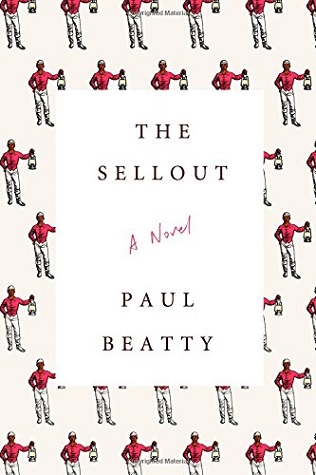
by by Margaret Kolb

Published by Farrar, Strauss and Giroux, 2015 | 289 pages
There was a time when “postmodernism” – with its extreme self-referentiality, hyperbolic irony, outrageous pastiche, and mock-scholarly footnotes – was a buzzword for aesthetic innovation so radical that it threatened to make storytelling itself untenable as a form. With time, and much imitation, however, the practices of masters such as Pynchon, Gass, DeLillo, D. F. Wallace gradually faded into a litany of requisite checkboxes: interminable digressions, divested allusions, the single-page chapter, and a barrage of every kind of marginalia from advertising jingles to quasi-legal charts, from opinion polls to news headlines. Today, it is a brave spirit indeed who attempts an explicitly unironic “postmodern” novel.
Paul Beatty’s newest novel, The Sellout (2015), does just that, ticking off every single checkbox in the postmodern playbook: it substitutes pastiche for plot, and farce for characterization; narrative action unfolds through elaborate and increasingly whimsical daydreams; it takes the single-page-chapter-rule so seriously that Chapter Two finds itself comprised only of the words: “Westside, nigger! What?” The number of digressions it takes to tell the story of Bonbon Me – Beatty’s narrator – would make even Tristram Shandy blush at the irreverence of his black, hypomanic, Los Angeleno successor. Superficially, The Sellout would appear to be an entirely conventional postmodern novel.
In terms of story, not much actually happens here. We learn that as a child Me was subjected to the mad-scientist experiments of his father, a Victor Frankenstein version of the psychologist Carl Jung. After Me’s father dies in a police altercation, Me learns that he has been bequeathed his father’s former patient, one Hominy Jenkins, who, despite Me’s initial protests, attaches himself to Me as a domestic slave. In the meantime, the fictional neighborhood of Dickens has recently “disappeared” from maps of LA. In his efforts to restore his hometown to the map, through one digressionary interlude after another, Me embarks on an absurd quest to reinstitute slavery and segregation, only to end up on trial in front of the Supreme Court for violating the Thirteenth and Fourteenth Amendments. The betrayal of centuries of racial progress in one irreverent swoop earns Me the triumphant eponymous title of the “Sellout.”
As the above summary suggests, much of the “action” of The Sellout is in Beatty’s portrayal of an American landscape that is resolutely our own via a surrealistic absurdism akin to that of Dada and other radical movements. Me’s world of Dickens is an inner-city rural neighborhood with rodeos, orchards, donut shops and shootouts. This is a town where “eight-year-olds who’ve already seen it all sit on rickety lawn chairs whittling with switchblades.” Me’s appointed public defender in the Supreme Court, with his “gold-capped incisor,” is an over-accessorized pimp. Me’s unreliability as a narrator makes itself felt with every passing remark, none of which are to be taken at face value. “Like most black males raised in Los Angeles,” Me says at one point, “I’m bilingual only to the extent that I can sexually harass women of all ethnicities in their native languages.”
If one detects a note of bitterness in this instance of bigotry taken to comic excess, it is because bitterness, even rage, at the immense violence and social injustice perpetrated by our society, suffuses Beatty’s novel. It is here, in Beatty’s repurposing of the litany of conventional postmodern stylings to political ends, that Beatty’s text powerfully transcends the limits of conventional postmodernism. Here, absurdism, metafictionality, and even digressions have a point, entering in crucial junctures to magnify Beatty’s trenchant denunciation of our national cultural passivity surrounding race relations. The novel is absurdist only until one grasps that it is instead a charged form of hyperrealism. Beatty’s response to entrenched, systematic racial oppression, to our absurd politics of gun violence or urban incarceration, is to maximize his novel’s verisimilitude by exaggerating his portrayal. Beneath the veneer of The Sellout’s hyperbolic indifference is a story of a generation’s heartbreak.
Central to Beatty’s aesthetic is the deft melding of the somber and the absurd into a confusion of belief and unbelief, calculated to offend, perturb, and finally, expose. Among Me’s many mental pictures is the “incessant Black History Month loop of barking dogs, gushing fire hoses, and carbuncles oozing blood through two-dollar haircuts,” led not by the dignified MLK Jr., but, anti-climatically, by the “head zombie” who ends the long march to the podium with the one-liner, “Things go better with Coke.” Elsewhere, Me brings up the tragedy of the displaced inhabitants of the post-Katrina Ninth Ward as a simile for the occupants of his intestinal tract, which, too, “had nowhere to go.” In yet another instance Me rather egregiously suggests that the Barbie version of Harriet Tubman has excellent “dick-sucking lips.” These are not simply examples of postmodern irreverence, but rather, deliberate deployments of racial bricolage that ultimately points out how racial discourse today has been co-opted a world where commercialization has replaced conversation and political correctness has replaced political action.
The novel’s catalogue of racial injustice finds its peak in America’s original sin: slavery. It is here that Beatty’s aesthetic of juxtaposing profundity with absurdity finds its logical climax. When Hominy first enlists under Me as his “Massa,” Me protests strenuously, only to elicit a response from his “slave” that perfectly illustrates The Sellout’s aesthetic of combining the somber with the absurd, revealing the bitter cracks in the mask of its comedy:
“Massa,” he said, the smile evaporating from his face, and shaking his head in that pitiable way people who you think you’re better than do when they catch you thinking you’re better than them, “sometimes we just have to accept who we are and act accordingly. I’m a slave. That’s who I am. It’s the role I was born to play. A slave who just also happens to be an actor. But being black ain’t method acting. Lee Strasberg could teach you how to be a tree, but he couldn’t teach you how to be a nigger. This is the ultimate nexus between craft and purpose, and we won’t be discussing this again. I’m your nigger for life, and that’s it.”This smile that evaporates from Hominy’s face is a smile familiar to literature, the same smile once worn by the intellectual malcontents Hamlet, Stephen Dedalus, and Holden Caulfield, the same brief, extradiegetic smile of someone who knows too much, someone who cannot believe they must abide by their (fictional) universe’s preposterous limits. In the case of The Sellout, these limits are the bounds set by institutional racism and tethered by political indifference, which are illuminated by flashes of surrealistic lightning before being once again enclosed by the novel’s crushing sardonicism. Not one moment after Hominy ends his speech does Me announce, smugly, to the reader, “I whipped the shit out of that nigger” – a troubling response, suffice it to say, whose political subversion is embedded in its slapstick incidence.
To create the hybrid mixture that is The Sellout, Beatty draws from two distinct literary traditions. On the one hand, his novel owes a great debt to the absurdist strain of postmodern literature: the tragicomic stories of George Saunders and urban fantasy worlds of John Cheever come to mind, as do the works of the three “Dons” of absurdist literature: DeLillo, Barthelme, and Antrim. One also detects a hint of acerbic Swiftian satire in Beatty’s caricature of the hyper-politically-correct Foy, who expurgates Huckleberry Finn with the principle: “Where the repugnant ‘n-word’ occurs, I replaced it with the word ‘warrior’ and the word ‘slave’ with ‘dark-skinned volunteer.’” On the other hand, Beatty draws from an older African-American tradition grounded in the centrality of location to identity. The intractable connection between Me and his fictional East LA recalls the deep links forged between character and place in August Wilson’s Pittsburgh or Jean Toomer’s Georgia. This is not to say, however, that the novel does not also resonate with a more contemporary African American literary mode, earmarked by a subversive irony once dubbed by Henry Louis Gates (of beer summit fame) as the “Signifyin’ Monkey.” The Sellout’s astute but manic protagonist, equally literate in urban-slang and classical literature, drips antiestablishment animosity with every wisecrack, much like the characters that dot the pages of Ralph Ellison or Ishmael Reed.
In the final evaluation, Beatty’s novel does the serious work of racializing the genre of absurdist literature – or conversely, the comic work of rendering as absurd the literary depiction of race. Whichever way one looks at it, The Sellout remains a delightful, imaginative, and incendiary novel whose racial critique cannot be reduced to mere postmodern affectation. From the Supreme Court officers marching like a “wagonless team of crew-cut Clydesdales harnessed together by a love of God and country” to the salute of “the Washington Monument touching the night sky like a giant middle finger to the world,” Beatty’s The Sellout is a contribution to the project of black radicalism that brandishes a weapon as effective as it is underutilized: the absurd.
Allen Zhang is an English PhD candidate at UCLA. His research is primarily focused on twentieth-century literature. He received his BA in English from Dartmouth College.















click to see who
MAKE Magazine Publisher MAKE Literary Productions Managing Editor Chamandeep Bains Assistant Managing Editor and Web Editor Kenneth Guay Fiction Editor Kamilah Foreman Nonfiction Editor Jessica Anne Poetry Editor Joel Craig Intercambio Poetry Editor Daniel Borzutzky Intercambio Prose Editor Brenda Lozano Latin American Art Portfolio Editor Alejandro Almanza Pereda Reviews Editor Mark Molloy Portfolio Art Editor Sarah Kramer Creative Director Joshua Hauth, Hauthwares Webmaster Johnathan Crawford Proofreader/Copy Editor Sarah Kramer Associate Fiction Editors LC Fiore, Jim Kourlas, Kerstin Schaars Contributing Editors Kyle Beachy, Steffi Drewes, Katie Geha, Kathleen Rooney Social Media Coordinator Jennifer De Poorter
MAKE Literary Productions, NFP Co-directors, Sarah Dodson and Joel Craig